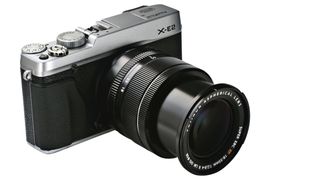Why you can trust TechRadar
As we have seen the sensor and processing engine before, in the X100s, it's no surprise to discover that the X-E2 generally produces high-quality images with plenty of detail and well-controlled noise.
However, at 100% on screen, out of focus areas in JPEG images have a watercolour-like appearance and some strong edges border on being over-sharpened. The painterly effect seems to be the result of the camera attempting to sharpen areas that should not be sharp. Fortunately, this effect isn't visible at normal viewing sizes and images look good with a film-like quality, but it will limit print sizes and cropping. Even better news is that the problem does not extend to simultaneously-captured raw files.
Noise is controlled impressively well throughout the native sensitivity range: ISO 200-6400. Even shots taken at ISO 6400 have little chroma noise, with just subtle coloured speckling being visible in the darker (but non-black) areas. This coloured speckling can be fairly easily removed, for example using the Colour slider in the Noise Removal section of Adobe Camera Raw, to leave luminance noise.
It's not possible to capture raw files at the sensitivity expansion settings, but the JPEG results are pretty good. As you'd expect, ISO 25,600 JPEGs look softer than those captured lower down the range, but they are pretty good, and in some cases would make respectable A3 prints.
Fuji's automatic white balance system has impressed before and it doesn't disappoint in the X-E2, delivering natural-looking colours in a range of situations. However, in overcast and shaded conditions the Fine Weather setting produces slightly warmer, more pleasing results.
Similarly, the standard Provia Film Simulation mode is a good choice for many conditions, but the Velvia option is good when you want to boost colors. I particularly like the results in BW mode, with the Highlight and Shadow tone set to their maximum values (+2) to boost contrast. In many cases, monochrome images look good straight from the camera, but it's nice to have the raw file to process if you decide you want a colour image or a more considered black and white conversion.
Despite the claims made for the X-E2's automatic focusing system, it doesn't seem quite as fast as the systems in the likes of the Panasonic G6, Panasonic GF6 or Olympus E-P5. Nevertheless, it is good and an improvement upon the X-E1's AF system, delivering sharp images quickly in most situations. As usual, it slows down a bit and becomes a little indecisive when light levels fall, but it's not bad and a lot better than the AF systems available in an average SLR's live view mode.
The biggest improvement is made with continuous focusing, which in the past was largely unusable, but now performs well - provided you have the active AF point over the subject.
Rather than locking to the central AF point when continuous AF mode is selected, the AF point can be positioned as normal within the frame and, in reasonable light, it locks on to the target quickly, keeping it in focus as the subject distance changes. I found it was able to get cyclists sharp as they pedaled towards me.

Our tests reveal that the X-E2's general purpose metering system does a good job with exposure in most situations, but the exposure compensation dial comes in handy occasionally, especially when you want to protect the highlights.
Raw files prove their worth in high-contrast conditions, as their greater dynamic range allows more detail to be retrieved from both shadows and highlights. It is impressive how much detail can be drawn from very dark shadow areas, even in images captured at high-sensitivity settings.
Naturally, this needs to be done with care, as brightening shadows brings out noise, but there's no banding and it's possible to strike a good, natural-looking balance.
Our lab tests confirm our findings in the field, that the X-E2's JPEG files have a slightly restricted depth of field and highlights are clipped a little more easily than we might like in high-contrast conditions. On the plus-side, in average conditions JPEG images have a nice level of contrast straight from the camera.

